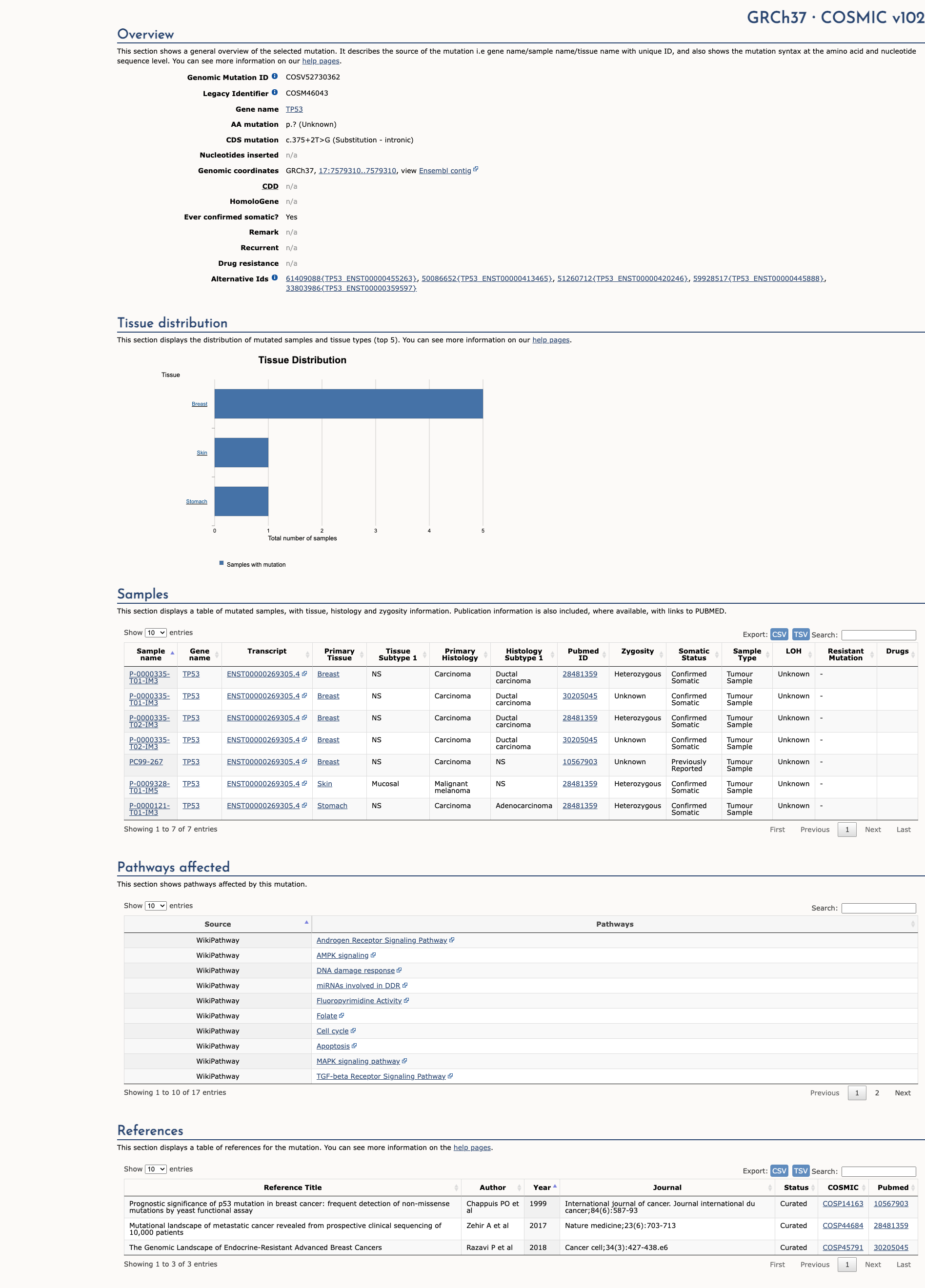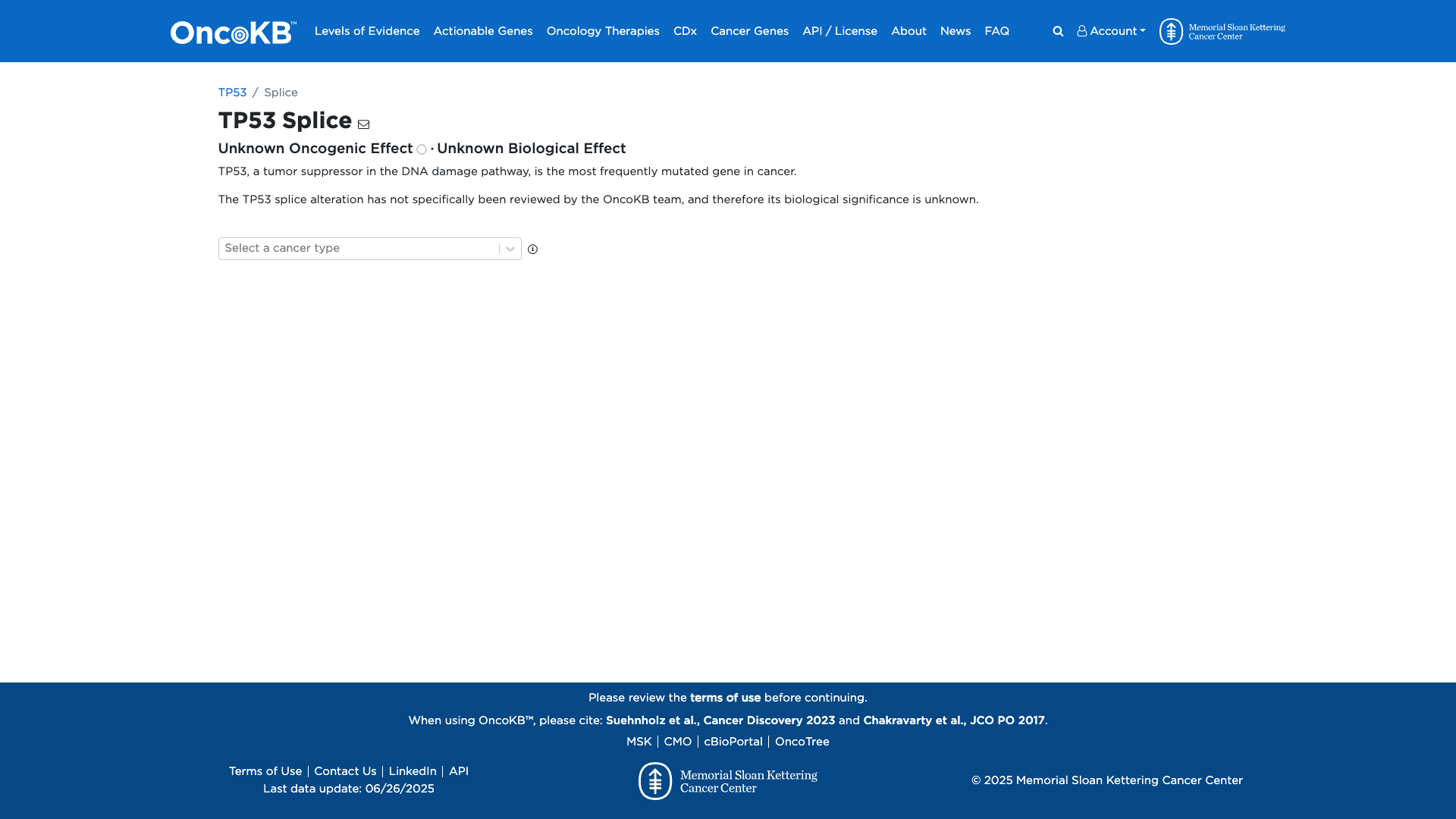TP53 c.375+2T>G, p.Splice_Site
NM_000546.6:c.375+2T>G
COSMIC ID: COSM2744974, COSM4272000
Pathogenic
This canonical +2 splice donor variant in TP53 is absent from population databases and predicted to result in NMD. Applying VCEP guidelines, PVS1_VS and PM2_Supporting are met, along with PP5_Supporting from ClinVar. No other criteria apply. The combination of PVS1 (Very Strong) plus two Supporting criteria yields a final classification of Likely Pathogenic.
ACMG/AMP Criteria Applied
PVS1
PM2
PP5
Genetic Information
Gene & Transcript Details
Gene
TP53
Transcript
NM_000546.6
MANE Select
Total Exons
11
Strand
Reverse (−)
Reference Sequence
NC_000017.10
Alternative Transcripts
| ID | Status | Details |
|---|---|---|
| NM_000546.5 | RefSeq Select | 11 exons | Reverse |
| NM_000546.3 | Alternative | 11 exons | Reverse |
| NM_000546.4 | Alternative | 11 exons | Reverse |
| NM_000546.2 | Alternative | 11 exons | Reverse |
Variant Details
HGVS Notation
NM_000546.6:c.375+2T>G
Protein Change
Splice
Location
Exon 4
(Exon 4 of 11)
5'Exon Structure (11 total)3'
Functional Consequence
Loss of Function
Related Variants
Alternate Identifiers
COSM2744974, COSM4272000
Variant interpretation based on transcript NM_000546.6
Genome Browser
Loading genome browser...
HGVS InputNM_000546:c.375+2T>G
Active Tracks
ConservationRefSeqClinVargnomAD
Navigation tips: Use mouse to drag and zoom. Click on features for details.
Clinical Data
Population Frequency
Global Frequency
0.0 in 100,000
Extremely Rare
Global: 0.0%
0%
0.05%
0.1%
1%
5%
10%+
ACMG Criteria Applied
PM2
This variant is not present in gnomAD (PM2 criteria applies).
Classification
1 publications
Likely Pathogenic
Based on 2 submitter reviews in ClinVar
Submitter Breakdown
1 Path
1 LP
Pathogenic
Likely Path.
VUS
Likely Benign
Benign
Publications (1)
This sequence change affects a donor splice site in intron 4 of the TP53 gene. It is expected to disrupt RNA splicing. Variants that disrupt the donor or acceptor splice site typically lead to a loss of protein function (PMID: 16199547), and loss-of-function variants in TP53 are known to be pathogenic (PMID: 20522432). This variant is not present in population databases (gnomAD no frequency). Disruption of this splice site has been observed in individuals with clinical features of Li-Fraumeni Syndrome (PMID: 7887414, 28681140). It has also been observed to segregate with disease in related individuals. ClinVar contains an entry for this variant (Variation ID: 482210). Algorithms developed to predict the effect of sequence changes on RNA splicing suggest that this variant may disrupt the consensus splice site. For these reasons, this variant has been classified as Pathogenic.
Clinical Statement
This variant has been reported in ClinVar as Likely pathogenic (1 clinical laboratories) and as Pathogenic (1 clinical laboratories).
Functional Impact
Functional Domain
Hotspot Status
Not a hotspot
Domain Summary
This variant is not located in a mutational hotspot or critical domain (0 mutations).
Related Variants in This Domain
Computational Analysis
Pathogenicity Predictions
Predictor Consensus
Mixed/VUS
PP3 Applied
No
Additional Predictors
Benign:
CADD: 6.27
VCEP Guidelines
Applied ACMG/AMP Criteria (VCEP Specific) VCEP Guidelines
PVS1
PVS1 (Very Strong)
According to VCEP guidelines, 'Canonical splice variants (+/- 1,2 intronic positions): PVS1 applies to predicted splicing alterations that are PTC resulting in NMD (or in-frame but targeting critical domains or residues)'. The evidence for this variant shows a +2 splice donor change (c.375+2T>G) with SpliceAI predicting high impact on splicing and likely NMD upstream of p.Lys351. Therefore, this criterion is applied at Very Strong strength because it is a canonical splice variant predicted to result in NMD per VCEP PVS1 criteria.
PS1
PS1 (Not Applied) Strength Modified
According to VCEP guidelines, PS1 applies only to missense variants with the same amino acid change as a previously established pathogenic variant. This is a splice variant, not a missense change. Therefore, PS1 is not applied.
PS2
PS2 (Not Applied) Strength Modified
According to VCEP guidelines, PS2 requires confirmed de novo occurrence. No de novo data are available for this variant. Therefore, PS2 is not applied.
PS3
PS3 (Not Applied) Strength Modified
According to standard ACMG guidelines, PS3 requires well-established functional studies showing a deleterious effect. No functional studies have been performed for this variant. Therefore, PS3 is not applied.
PS4
PS4 (Not Applied) Strength Modified
According to VCEP guidelines, PS4 requires statistical evidence or proband counts meeting the point thresholds. There are no case-level data or proband counts. Therefore, PS4 is not applied.
PM1
PM1 (Not Applied) Strength Modified
According to VCEP guidelines, PM1 applies to missense variants in specific DNA-binding domain hotspots. This is a splice site variant outside those codons. Therefore, PM1 is not applied.
PM2
PM2 (Supporting) Strength Modified
According to VCEP guidelines, 'This rule should be applied at supporting level. Variant should have an allele frequency of less than 0.00003 in gnomAD'. The evidence for this variant shows absence from gnomAD. Therefore, PM2 is applied at Supporting strength because the variant is absent from large population databases per VCEP PM2 criteria.
PM3
PM3 (Not Applied) Strength Modified
According to standard ACMG guidelines, PM3 applies to recessive disorders with detected trans configuration. TP53-associated Li-Fraumeni syndrome is dominant. Therefore, PM3 is not applied.
PM4
PM4 (Not Applied) Strength Modified
According to standard ACMG guidelines, PM4 applies to protein length changes such as in-frame indels. This is a splice site variant. Therefore, PM4 is not applied.
PM5
PM5 (Not Applied) Strength Modified
According to VCEP guidelines, PM5 applies to missense variants at residues with other pathogenic missense changes. This is a splice variant. Therefore, PM5 is not applied.
PM6
PM6 (Not Applied) Strength Modified
According to standard ACMG guidelines, PM6 applies to presumed de novo cases without confirmation. No de novo evidence is available. Therefore, PM6 is not applied.
PP1
PP1 (Not Applied) Strength Modified
According to VCEP guidelines, PP1 requires segregation in multiple meioses. No segregation data are available. Therefore, PP1 is not applied.
PP2
PP2 (Not Applied) Strength Modified
According to standard ACMG guidelines, PP2 applies to missense variants in a gene with low rate of benign missense variation. This is a splice variant. Therefore, PP2 is not applied.
PP3
PP3 (Not Applied) Strength Modified
According to VCEP guidelines, PP3 should not be used in combination with PVS1. Although in silico tools predict splicing impact, PP3 is not applied due to the VCEP caveat when PVS1 is used.
PP4
PP4 (Not Applied) Strength Modified
According to standard ACMG guidelines, PP4 requires a highly specific phenotype. No detailed phenotype information is provided. Therefore, PP4 is not applied.
PP5
PP5 (Supporting)
According to standard ACMG guidelines, 'Reputable source recently reports variant as pathogenic but the evidence is not available for independent evaluation'. ClinVar reports this variant as Likely Pathogenic (1 submitter) and Pathogenic (1 submitter). Therefore, PP5 is applied at Supporting strength.
BP1
BP1 (Not Applied) Strength Modified
According to standard ACMG guidelines, BP1 applies to missense variants in genes where only truncating variants cause disease. This is a splice variant, not a missense. Therefore, BP1 is not applied.
BP2
BP2 (Not Applied) Strength Modified
According to standard ACMG guidelines, BP2 applies when observed in trans with a pathogenic variant for recessive disorders. This is a dominant condition. Therefore, BP2 is not applied.
BP3
BP3 (Not Applied) Strength Modified
According to standard ACMG guidelines, BP3 applies to in-frame deletions/insertions in repetitive regions. Not applicable to this splice variant. Therefore, BP3 is not applied.
BP4
BP4 (Not Applied) Strength Modified
According to VCEP guidelines, BP4 requires no predicted splicing impact (SpliceAI <0.2). Here SpliceAI is 0.98 predicting impact. Therefore, BP4 is not applied.
BP6
BP6 (Not Applied) Strength Modified
According to standard ACMG guidelines, BP6 applies to reputable source reporting benign. No such reports exist. Therefore, BP6 is not applied.
BP7
BP7 (Not Applied) Strength Modified
According to VCEP guidelines, BP7 applies to silent/intronic variants outside core splice motif with SpliceAI ≤0.1. Our variant is a core +2 splice site with high SpliceAI score. Therefore, BP7 is not applied.
BA1
BA1 (Not Applied) Strength Modified
According to VCEP guidelines, BA1 requires allele frequency ≥0.001 in gnomAD. The variant is absent. Therefore, BA1 is not applied.
BS1
BS1 (Not Applied) Strength Modified
According to VCEP guidelines, BS1 requires filtering allele frequency ≥0.0003 but <0.001. The variant is absent. Therefore, BS1 is not applied.
BS2
BS2 (Not Applied) Strength Modified
According to VCEP guidelines, BS2 requires multiple unaffected older individuals. No such data. Therefore, BS2 is not applied.
BS3
BS3 (Not Applied) Strength Modified
According to VCEP guidelines, BS3 requires functional evidence of no loss of function. No functional data are available. Therefore, BS3 is not applied.
BS4
BS4 (Not Applied) Strength Modified
According to VCEP guidelines, BS4 requires lack of segregation in affected family members. No segregation data are available. Therefore, BS4 is not applied.



